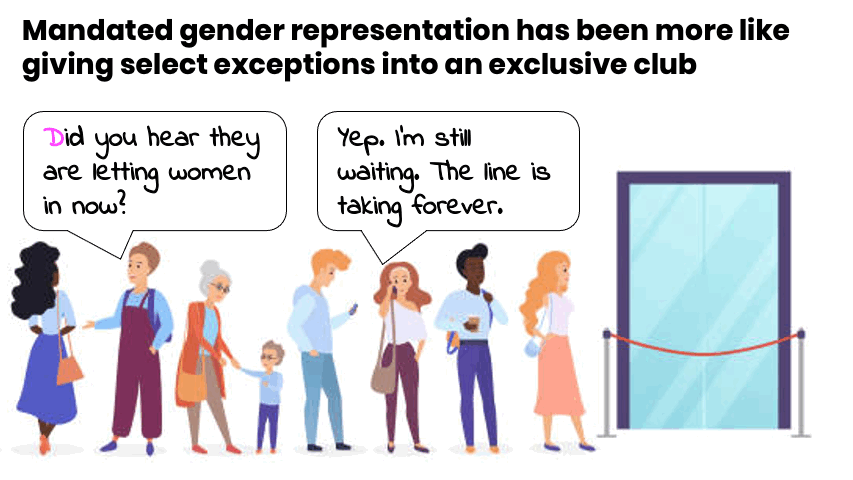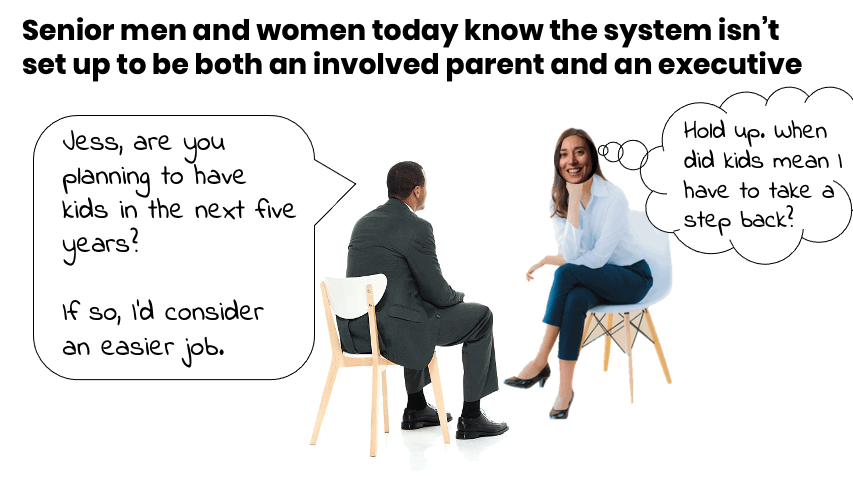👋 to the 90 folks who question the way things are today and are proactively shaping our collective future.
Not a subscriber? Click that pretty pink button below to join the crew.
Newsletter overload? Set your 👀 s on the 3 gifs and Parting Words. You’ll get the answer to today’s focus: Is it time to just admit we won’t ever have equal representation of women and men in positions of power?
The Opening Spiel
This is my second (and final) follow-up on the op-ed I wrote in response to Globe & Mail’s series on the gap between men and women in positions of power. Flexibility was proposed as a solution and I believe that flexible schedules for only some actually hinders gender equality in the senior ranks. While the flextime worker (mainly women) rushes out to do daycare pickup, everyone else (mainly men) is progressing their career.
To get 50/50 gender representation in positions of power, I suggested two alternative policies:
1) have everyone work fewer hours from the CEO to the front-line
2) pay for the support women need, like outsourcing child care to a nanny, when they reach management level.
There was another route I considered and didn’t have room to expand on. Again - my thanks go to the gods of Substack and the ability to self-publish my ideas.
The other route is to address the power gap is to just admit the jig is up and we won’t hit 50/50 representation in positions of power.
All the people who have fought for gender equality would cringe at reading this. But, it is worth considering.
Evaluating whether to call it quits will either a) relieve the pressure on the billions of women struggling to live up to the #femalepower messages or b) hone in on the solutions that will actually get us over the final hump of change.
Let’s explore.
Reason #1 to give up: Females will always be the ones to have children.
There has been tremendous progress in achieving gender equality. We’ve largely closed the gap related to health and educational attainment, according to the World Economic Forum Gender Gap Index. So women now live as long and we are good at getting degrees. The slowest moving gap, however, is in economic participation and opportunity. According to WEF, it will take 257 years at current progress to close this particular gap.
So what would it take for women to ascend the corporate ladder and receive equal pay for equal work? For sure, we’d have to eliminate all the gender biases and workplace norms holding women back. But, there is still one biological truth that no progressive policy can change: females are the ones to bear children.
As a result, there will always be a reason for females to pull back from work more so than males. Let’s play this out in detail...
A female who gives birth is behind an equal male for a minimum of six months per child. The month before having the baby is pretty well a write off at work. Even if there is absolutely no prejudice towards a very pregnant woman, after eight months of growing another human inside you there just isn’t much left in the tank and you’re focused on wrapping things up. Then once the baby comes, you’re looking at another four to six months at a minimum. Sure, women can go back to work weeks after giving birth - I went back after six weeks - but the same energy just isn’t there.
Do that two times and you’re looking at a year. That isn’t so bad. But that’s the most optimistic, human-as-machine scenario.
The reality is more like this:
Because women are having kids later as they put their careers first, there is a lot more stress and time spent trying to conceive (daily cycle monitoring is a time suck!)
Then you get preggers and that first trimester all you want to do is eat everything in the fridge and then sleep. Definitely no after work socializing or later nighters.
The second trimester is usually a breeze in comparison but then month six hits and all you really want to be is horizontal like a beached whale come 7:30pm
Once the baby comes, there is a huge range from under four months to up to two years that women will typically spend away from work
Once the child is a year or two, women continue to do more caregiving than men, even when both work. As a result, career interruptions continue to be higher for women, than men, throughout the child’s first 15-18 years. There may be extraneous circumstances, or just the normal day-to-day routine that a parent needs to be present for, like consistent family dinners that have been shown to improve academics, mental health, self-esteem and a whack of other good things any parent wants for their kids.
So once a female has kids - which is a choice as well as an overall benefit for society (look to Japan to see what happens when you have low birth rate) - on average, it has been proven that her career is going to take a hit.
Now, it is important to mention that this isn’t to say that fathers, or other co-caregivers, do nothing. It is just to say that on average, females do more unpaid caregiving and housework and most of this originates from the fact that they are the ones to bear children.
But us humans are smart. We can change social norms and laws to adapt to our values, despite biological certainties. We can shift so that both men and women take up equal home and work duties so they can take equal presence at the top of the corporate ladder. Right?
Reason #2 to call it quits: Mandated representation policies don’t work out as planned.
Instead of waiting 257 years for gender parity at the senior ranks, countries have mandated it to be so (or rather, almost parity). Sadly, this has had lacklustre results.
There are two basic kinds of measures in play right now: targets and quotas. Canada has taken the target approach with our “comply or explain” model. This requires all companies listed on the Toronto Stock Exchange to either disclose how many women were on their board and in executive roles or explain why they don’t have gender representation policies. But while there has been improvement only 22% of Board roles were held by women in Canada.
For those that don’t disclose their practices to increase female representation on their board, they often use the exact same wording to explain why: “Our decisions are strictly merit-based. There are a lack of qualified female candidates. We don’t believe targets will result in identifying the best candidates.”
This statement directly points to a key missing piece of these policies: they didn’t go far enough to change the norms so that women would qualify as senior leaders. They didn’t change what was considered as “merit” (think: broaden the desired characteristics, include skills gained while full time caregiver). They also didn’t change the caregiving support (think: getting men to put in more time, paying for nannies). See Parting Words for a solution to these issues.
In terms of quotas, Norway was one of the first to introduce a gender quota in 2003. What happened was that a small group of women took on many board seats. They called this the “golden-skirt phenomenon”. This social engineering has been replicated in Australia and resulted in seven out of ten most powerful board directors in Australia are women. However, women hold only 30% of all seats which means there is a huge concentration Board members among few women in Australia. India’s measures also didn’t go far enough as despite the uptick in women on boards, they remained on the sidelines and out of the key committees.
Not only do the measures related to director representation not show signs of a sustainable path to gender parity, it also doesn’t trickle down to more female operating executives. The representation of women executives, whether in countries with quotas, targets or nothing at all, are still drastically underrepresented. Take France, as an example, where quotas have led to near gender equality with 44% of board seats held by women. However, at the executive level, female representation is just 18%. Why is this? They find non-executive women to fill the Board and have left the workplace practices intact, thereby making it much harder for women who hold caregiving duties to succeed.
So what’s stopping us from really doing things right and making 50/50 a reality?
Reason #3 to call it quits: I’m not convinced senior leaders think it can be 50/50.
I only have unscientific anecdotes for this point so bear with me as I explain...
I’ve been fortunate to have a lot of mentors throughout my career and both men and women acknowledge that having kids impacts one’s career and that ascent as a female requires extra sacrifices men don’t have to make. This was stated more as fact, though, than as an issue that needed sizeable change.
The senior females who shared their tips for managing their careers and kids were in the “you gotta tough it out” camp. I’ll never forget the small woman’s event where the host talked about how her daughter would cry while she was travelling and ask her to come home and read a bedtime book. She wanted us to know what it would take to have a successful career as a mom. That one example was repeated countless times in slight variations, all conveying the message that I would have to sacrifice home life and put in extraordinary effort as a female.
As for my male mentors, their career and family advice didn’t come in sly or coded comments. It was an explicit criteria to think about when I presented them with the question of whether I should look for a new job or start a new business. In their opinion, if I wanted to make a major change in my career, I should consider doing it before or after the years when my kids were young.
Initially, I scoffed at the idea that I would steer my career differently than my male counterparts. I could take on a new job if my kid was 1, 11 or 21 years old. But after time, I realized that they were right. I appreciate their honesty with how the system works and not trying to pull the wool over my eyes.
So if both senior men and women think that someone has got to be home with the kids and it’s most likely the woman, how does this translate to decisions made in the boardroom? Do they allocate resources or sponsor initiatives differently than if they were fervent champions of a 50/50 C-Suite? How linked is this to progress in reason #2?
The one and only reason why I’ll continue to push for gender equality: I want it.
I love my daughter. But I’m a better mom when I’m working. Work energizes me and brings me back at the end of the day a better person. I also know I am a damn good business person. I have lots to contribute to the professional world, including my nurturing skills.
That’s it. No economic value, improved company performance or moral rationale. The fact that I want it should suffice to make 50/50 representation a reality. In our modern society, we have more resources that we need to survive. We can make it so if we want to.
Parting Words
My whole life I believed I could do anything. Throughout school, university and my first years working, I was privileged enough to see no barriers to what I could accomplish.
Then when I had a baby I realized there is actually an impediment and it has nothing to do with my skills or capabilities. There is another human to care for, I was the likely candidate to do so and caregiving work isn’t highly valued by our economy.
Token measures like a bringing in a speaker on female empowerment during IWD or sponsoring a management training program for women won’t solve anything. I don’t need more inspiration or coaching.
Instead, I need real solutions like Parentsmart Employers, which is educating employers on how to include non-paid caregiving in their assessment of employees. There are transferable work skills gained in unpaid care, we just don’t see them.
And, pay people the same hourly wage if they work part-time or full-time. If it is the same work just done for fewer hours a week, there should be no reason why wages increase in a non-linear fashion (i.e., two people working 30 hours a week will make less combined than one person working 60 or more).
And, include unpaid caregiving and housework in GDP. This has been considered for the past thirty years when Marilyn Waring first wrote about it in her book “If Women Counted”. This is not only the right thing to do, it also might lead to more men taking on traditionally unpaid work.
What is unique about these measures is that they don’t overlook the fact that during a major part of one’s career, employees are most likely responsible for mini-humans. The faster workplaces and overall economy acknowledge that all workers - male and female - are also caregivers, the faster we’ll see more women in senior ranks.
My thanks to Karin, Rachel and Dan for their input on this post. 🙏💕
If you liked this post, there are two amazing 🎁 you can give in return:
Join the crew by subscribing. 👇🥳
Share this with someone else you think would enjoy it.👇🥳🥳







